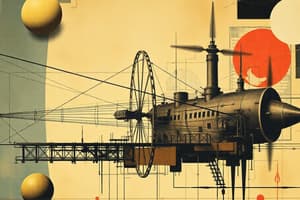Podcast
Questions and Answers
न्यूटनच्या तालमीतल्या कोणत्या सिद्धांतानुसार, विश्रांतीत असलेले वस्तू फक्त बलानेच हलतात?
न्यूटनच्या तालमीतल्या कोणत्या सिद्धांतानुसार, विश्रांतीत असलेले वस्तू फक्त बलानेच हलतात?
- दूसऱ्या सिद्धांत
- तिसऱ्या सिद्धांत
- पहिल्या सिद्धांत (correct)
- कायनेटिक्स
घर्षणात्मक बल म्हणजे दोन पृष्ठभागामध्ये संपर्कामुळे निर्माण होणारी प्रतिरोधकता.
घर्षणात्मक बल म्हणजे दोन पृष्ठभागामध्ये संपर्कामुळे निर्माण होणारी प्रतिरोधकता.
True (A)
उष्णता हस्तांतरणाचे तीन मुख्य तत्त्वे कोणती?
उष्णता हस्तांतरणाचे तीन मुख्य तत्त्वे कोणती?
संवहन, संवहन, आणि विकिरण
ओहमच्या विधानानुसार, V = I x ____.
ओहमच्या विधानानुसार, V = I x ____.
पुढील यादीतील पदार्थांचे प्रकार त्यांच्या या परिस्थितीशी जुळवा.
पुढील यादीतील पदार्थांचे प्रकार त्यांच्या या परिस्थितीशी जुळवा.
रवायतींच्या दृष्टीने, हलक्या व हलका उडणार्या वस्तूंचा बाधक प्रभाव असतो का?
रवायतींच्या दृष्टीने, हलक्या व हलका उडणार्या वस्तूंचा बाधक प्रभाव असतो का?
उष्णता हस्तांतरणाचे एकमेव प्रकार आहे संवेग.
उष्णता हस्तांतरणाचे एकमेव प्रकार आहे संवेग.
ट्रेनचे गती मॉडेल कोणते तत्त्व लागू करतात?
ट्रेनचे गती मॉडेल कोणते तत्त्व लागू करतात?
उष्णता आणि ____ आमच्या सिग्नल आणि संवाद प्रणालींचा भाग आहेत.
उष्णता आणि ____ आमच्या सिग्नल आणि संवाद प्रणालींचा भाग आहेत.
Study Notes
Basic Principles of Science Relevant to Railways
-
Physics:
- Newton's Laws of Motion:
- First Law: An object at rest stays at rest unless acted on by a force.
- Second Law: F=ma (Force equals mass times acceleration).
- Third Law: For every action, there is an equal and opposite reaction.
- Kinematics: Study of motion, including velocity, acceleration, and displacement.
- Dynamics: Analysis of forces and their effect on motion.
- Newton's Laws of Motion:
-
Mechanics:
- Types of Forces:
- Gravitational: Pull exerted by the earth.
- Frictional: Resistance between two surfaces in contact.
- Tension: Force transmitted through a string or rope.
- Coupling and Uncoupling: Understand the mechanics of how train cars connect and disconnect.
- Types of Forces:
-
Thermodynamics:
- Heat Transfer: Conduction, convection, and radiation principles.
- Steam Engines: Basics of how steam drives pistons and creates power.
Electrical Fundamentals
-
Basic Circuit Theory:
- Ohm's Law: V=IR (Voltage equals current times resistance).
- Series and Parallel Circuits: Differences in voltage and current distribution.
-
Electromagnetism:
- Electromagnetic Induction: How electric currents can create magnetic fields and vice versa.
- Generators and Motors: Principles of how they operate in trains.
Materials Science
- Properties of Materials:
- Stress and Strain: Understanding deformation under load.
- Fatigue: Concept of how materials weaken over time.
- Metals Used in Railways: Common materials include steel and aluminum, known for strength and resilience.
Safety and Maintenance
-
Safety Protocols:
- Importance of following proper procedures and regulations.
- Understanding the significance of Personal Protective Equipment (PPE).
-
Routine Maintenance:
- Inspection of tracks, rolling stock, and signaling systems.
- Lubrication and repairs to mechanical systems.
Signals and Communication
-
Types of Railway Signals:
- Indication of train movements and track conditions.
- Signal aspects: Color codes, shapes, and meanings.
-
Communication Systems:
- Importance of clear communication between crew members.
- Use of radios and signaling devices.
Environmental Science
- Impact of Railways:
- Reduce Carbon Footprint: Efficiency of trains vs. cars, and planes in transporting goods and passengers.
- Noise and Vibration Control: Mitigation measures for surrounding communities.
Conclusion
- Goal for Grade 3 Exam:
- Understand fundamental scientific principles and their application in railway technology.
- Knowledge of safety, maintenance practices, and the operational aspects of trains.
रेल्वेसाठी प्रासंगिक विज्ञानाची मूलतत्त्वे
- भौतिकशास्त्र:
- न्यूटनचे गतीचे नियम:
- पहिला नियम: स्थिर असलेली वस्तू स्थिरच राहते, जोपर्यंत तिच्यावर कोणताही बल कार्य करत नाही
- दुसरा नियम: F=ma (बल म्हणजे वस्तुमान वेळा प्रवेग)
- तिसरा नियम: प्रत्येक क्रियेसाठी समान आणि विरुद्ध प्रतिक्रिया असते.
- गतिजशास्त्र: गतीचा अभ्यास, ज्यामध्ये वेग, प्रवेग आणि विस्थापन समाविष्ट आहे.
- गतिकशास्त्र: बलांचे विश्लेषण आणि गतीवर त्यांचा परिणाम.
- बलांचे प्रकार:
- गुरुत्वाकर्षण: पृथ्वीने आकर्षित केलेले आकर्षण बल.
- घर्षण: संपर्कात असलेल्या दोन पृष्ठभागांमधील प्रतिकार.
- तणाव: तार किंवा दोरीद्वारे प्रसारित होणारे बल.
- जोडणे आणि जोडणे सोडणे: रेल्वे गाड्या कशा जोडतात आणि कशा जोडतात याचे यांत्रिकी समजून घेणे.
- उष्मागतिकशास्त्र:
- उष्णता हस्तांतरण: चालन, संवहन आणि विकिरण तत्त्वे.
- भाप इंजिन: भाप पिस्टनला कसे चालवते आणि शक्ती कशी निर्माण करते याचे मूलभूत तत्त्वे.
- न्यूटनचे गतीचे नियम:
विद्युत मूलतत्त्वे
- मूलभूत सर्किट थिअरी:
- ओमचा नियम: V=IR (व्होल्टेज म्हणजे प्रवाहाचा वेळा प्रतिरोध).
- मालिका आणि समांतर सर्किट: व्होल्टेज आणि प्रवाहाच्या वितरणातील फरक.
- विद्युतचुंबकत्व:
- विद्युतचुंबकीय प्रेरणा: विद्युत धारा चुंबकीय क्षेत्र कशी निर्माण करू शकतात आणि उलट कशी.
- जनरेटर आणि मोटर्स: रेल्वे गाड्यांमध्ये त्या कशा कार्य करतात याची तत्त्वे.
पदार्थ विज्ञान
- पदार्थांचे गुणधर्म:
- ताण आणि विकृती: भारखाली विकृती समजून घेणे.
- थकवा: कालांतराने पदार्थ कसे कमकुवत होतात याची संकल्पना.
- रेल्वेत वापरले जाणारे धातू: पातळी आणि अॅल्युमिनियम हे सामान्य पदार्थ आहेत, जे त्यांच्या सामर्थ्या आणि लवचिकतेसाठी ओळखले जातात.
सुरक्षितता आणि देखभाल
- सुरक्षितता प्रोटोकॉल:
- योग्य प्रक्रिया आणि नियम पाळण्याचे महत्त्व.
- वैयक्तिक सुरक्षेचे साहित्य (पीपीई) चे महत्त्व समजून घेणे.
- नियमित देखभाल:
- ट्रॅक, रोलिंग स्टॉक आणि सिग्नलिंग सिस्टमची तपासणी.
- यांत्रिक प्रणालींसाठी स्नेहन आणि दुरुस्ती.
सिग्नल आणि कम्युनिकेशन
- रेल्वे सिग्नलचे प्रकार:
- रेल्वे गाड्यांच्या हालचाली आणि ट्रॅक परिस्थितीचे सूचन.
- सिग्नल पहलू: रंग कोड, आकार आणि अर्थ.
- संचार प्रणालीः
- क्रू सदस्यांमधील स्पष्ट संवादाचे महत्त्व
- रेडिओ आणि सिग्नलिंग उपकरणांचा वापर.
पर्यावरण विज्ञान
- रेल्वेचा परिणाम:
- कार्बन फूटप्रिंट कमी करणे: माल आणि प्रवाशांच्या वाहतुकीमध्ये रेल्वेची कार, विमानापेक्षा कार्यक्षमता.
- आवाज आणि कंपन नियंत्रण: आजूबाजूच्या समुदायांसाठी शमन उपाय.
निष्कर्ष
- तिसऱ्या दर्जाच्या परीक्षेचा उद्देश:
- रेल्वे तंत्रज्ञानात मूलभूत वैज्ञानिक तत्त्वे आणि त्यांचे अनुप्रयोग समजून घेणे.
- रेल्वे गाड्यांच्या सुरक्षितते, देखभालीच्या पद्धती आणि ऑपरेशनल पैलूंचे ज्ञान.
Studying That Suits You
Use AI to generate personalized quizzes and flashcards to suit your learning preferences.
Description
या प्रश्नपत्रिकेत भौतिकशास्त्र, यांत्रिकी आणि उष्णता श्रावणाबद्दलचे मूलभूत तत्त्वे समजून घेण्यात येतील. आणखी, सर्किट सिद्धांतावर लक्ष केंद्रित करण्यात येईल. हे विज्ञानाचे तत्त्वे रेल्वे प्रणालीतील आवश्यकतांसाठी महत्त्वाचे आहेत.




